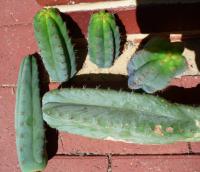

Skulking Lurker
-
Content count
212 -
Joined
-
Last visited
Posts posted by Skulking Lurker
-
-
-
Sounds like you are getting together a nice micro environment in your yard, bio.
I've had troubles keeping T. cacao alive over the years, here in Perth. It depends how
cold the winter gets.
Finally I did get one growing very well, and it acclimatised somewhat over successive
winters. About a metre tall, it was positioned in my front yard, until some lunatic
ran over it in a car, at night.
I'd love to source some more viable seed, or a plant to try again.
I contacted Daley's a few months ago, but they said all their sprouts had failed this year.
-
Can I ask where you got the Theobroma cacao from ???
I am looking for either viable seed, or a sapling.
Does anyone know where I can get these from ???
Thanks
-
I tried to sell some Hoodia gordonii plants on chEatbay 6 months ago, and they came down on me like a ton of bricks!!
I fucken hate the wanker ebay site.
I was selling H. gordonii pups, and they scrubbed my listing for selling live things. I informed them they weren't DOG PUPS,
they were plants.
Then they claimed I was trying to sell endangered plants !!!
I gave them no end of abusive replies. I hope they got the message, that I wasn't taking them from the flamin' wild,
and that they were raised in my backyard in Australia.
Since then I've completely boycotted the arseholes. Absolute bunch of idiots. I hate them all to death.
-
Hi, I don't know whether this'll be easy or hard, but can anyone tell me what this plant is?
untitled.bmp
-
Well, well, it's a small world.
I think I know where the described cacti are. A couple of years ago, I went to buy a tractor from the guy, and noticed several enormous Trichs around the property. During negotiations for the tractor, I subtly referred to the specimens, without giving anything away, and the nonchalantly naive response indicated that he was blissfully unaware of their pedigree and heritage.
It's quite obvious, that someone has subsequently informed him of such.
-
Thanks Rev, from the quick look I had at aqis, it doesn't appear to have any restrictions on import for quantities below commercial, but for something that is meant to be pretty common, it's bloody hard to find.
Whether it be due to seasonal availability, or whatever, I can't seem to track any down.
-
Does anyone know where I'd be able to acquire several suckers from this species?
Metroxylon sagu
I'm sick to death of being told it is Cycas revoluta, which it is not.
-
After being kicked out of heaven, Adam resorted to suicide bombing the cafe that god frequented.
Because the explosives were strapped around his belly, forensics were unable to determine whether or not he had a belly button.
-
Ahh, the joy to be in WA, where they are legal to operate.
I've only been done twice in 15 years, and that was because the music was up too loud.
New units pay for themselves within a month or two.
-
I'm having trouble believing the level of comment that seems to be coming from every corner of society, and feverishly relayed by the media, considering that it is all speculation at this stage, because nothing of the subject has actually been released yet.
-
There are a number of near-zero emission buses and taxis operating in Perth. Their power plant is a relatively normal internal combustion engine fueled by a gas delivery system not completely unlike an LPG system. The compression ratios are a little higher, and more H2 than other fuels is delivered into the engine, because liquified hydrogen has a very low specific energy(kW/L) to volume ratio, compared to petrol, and other fuels. The main problem with hydrogen as a fuel, is being able to carry enough of it around with you.
Hydrogen is no more dangerous than any other flammable gas. It won't just explode for no reason, unless it is mixed with oxygen, just as LPG, acetylene, or for that matter, coal dust would.
Producing hydrogen 'on board' by methods described , such as Sodium Borohydride, and electrolysis are not feasible, because of the quantities of hydrogen required to do anything. Electrolysis is in fact one of the worst means of separating the hydrogen and oxygen atoms, because of the vast electrical energy needed to produce anything worthwhile, due mainly to the fact that water doesn't ionise extensively, therefore its level of conductivity of electricity is very low indeed.
-
:cool:
-
I'm sure they'll have something to say on the subject.........
Otherwise, get gardening. The sooner, the sooner.
-
Quarantine is only interested in soil that may be attached to the plants.
AFAIK.
-
You could be a medicinal trial subject, Thelema..... then again, thinking a little more about it, any conclusions and/or inferences gained from the study, could only be described as skewed, extreme, incongruous, and certainly wouldn't do the legitimacy of the whole project any favours.
......And that's probably with the placebo !!
[ 17. March 2005, 20:44: Message edited by: Skulking Lurker ]
-
A 12 litre "Brava" LAGOSTINA
Made in Italy
-
-
Also, from this Previous thread
quote:
Pineapples are nearly always fertile, but highly self-incompatible. So as long as you only have one plant, or a whole field of a single variety, they are generally seedless. But if you have 2 plants of different varieties, and they happen to flower at the same time, they will make large numbers of seeds. The seeds are viable and fairly easy to grow, although slow. I wonder, though, if yours are the size of apple seeds, they may not be good. I'd say they should be more navy bean size.
That is how a grower ends up with seedless pineapples. By having clones of the same variety filling his field.
-
Usually they start by exhaustively breeding a shitload of hybrids, and then testing for taste, texture, colour, acid/sugar content, disease resistence, etc.
When an appropriate one is found, propagation begins.
From Landline.....
In the lush hills behind Nambour, the scientists at the DPI's Maroochy research station have been crossbreeding pineapples for 12 years. From 60,000 seedlings, a shortlist of six has been identified as having commercial potential.
The Department of Primary Industry's Garth Sanewski says they are looking for pineapples that are generally sweeter, lower in acid, with enhanced flavours, nice aroma, and a good internal appearance.
"Generally that means more yellow flesh," he said. "We're also looking for resistance to some of the disorders that we see in the normal cayenne so we're looking for reduced translucency, that is where the fruit can go overripe and fermented inside before it's externally ripe, we want resistance to that, we want resistance to cold season disorder called blackheart and we also want improved health benefits, high vitamin C, high vitamin A.
"We've principally been breeding for improved eating quality which is made up of high sugars, generally lower acid levels and a different range of volatiles or flavour components.
"We've also managed to increase the vitamin levels maybe vitamin E and A, which gives it a more yellow flesh, slightly more crunchy flesh in some cases, less translucency."
The new pineapples are not only sweeter and less acidic, each has a distinctly different taste.
"The traditional pineapple flavour will still be represented in some of them, others will be more like coconut, others are quite perfumed or aromatic, still others will have a fruit salad or a peachy flavour, still others will describe a mango flavour so there's a fairly big difference in the flavours of different pineapples,” Mr Sanewski said.
For growers like Gary Pike hybrid pines offer the chance to diversify.
"One of the problems, whenever you decide to go into a new variety whether it's a hybrid or one of your own farm-bred clones, it can be five to seven years from when you decide to go into it to when you finally become economical and that you're marketing them to their full potential,” Mr Pike said.
Nine years ago, Pinata Pines, run by brothers Gavin and Stephen Scurr introduced its own hybrid. Pinata is now the largest grower and distributor of fresh pineapple, supplying several supermarket chains around the country.
Gavin Scurr says it depends on who you see your competitor as.
"The more people that grow good pineapples the better it is for everyone and that's been demonstrated in the US particularly where this particular hybrid that we brought here has actually trebled the sales of pineapple in the whole US since that variety's become available there,” he said.
There is another reason why the introduction and marketing of hybrids in the marketplace can't come soon enough - imports.
Biosecurity Australia has cleared the way for imported pineapples from the Philippines. As yet none has arrived, but with a similar process underway for the much more lucrative banana industry, pineapple growers now have reason to be concerned.
Gavin Scurr says it is a threat.
"The varieties that they'd bring in would be the hybrid varieties they wouldn't be the smooth cayenne for instance, with the Aussie dollar continuing to rise it's making it easier for imports to come," he said.
-
Mine fruit all the time.
That is how a producer gets a field of the same variety, by cloning in just that manner.
-
quote:
Its very cheap.
Haha, not the way I make it!
-
Brugmansia spp.
-
quote:
I would use it but I have no use for aussie dollars and I imagine others have no use for usa dollars. Oh well, a nice idea anyway.
I find that they are both readily interchangeable at a ratio of about 3:4.
So if anyone out there who has no use for usa dollars, please forward them to me, and I'll go you halves. Likewise for aus dollars.

Pachanoi variant
in Cactus & Succulent Identification
Posted
I have had this speciman for well over a decade with no problems. The black rot seen is only on a previously damaged tip, which has been removed from the rest and discarded. It is only in the picture for its tip structure.
It does tend to 'fill out' like a sausage.